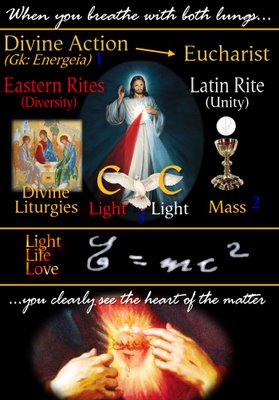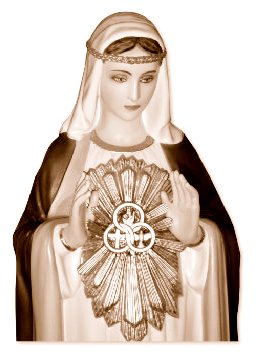J.M.J. + O.B.T. + M.G.R.*
Dear Brothers and Sisters,
1. "O superessential Trinity, infinitely divine and good, guardian of the divine wisdom of Christians, lead us beyond all light and everything unknown to the highest summit of the mystical Scriptures, where the simple, absolute and imperishable mysteries of theology are revealed in the luminous darkness of silence". With this prayer of Dionysius the Areopagite, an Eastern theologian (Theologia mystica, I, 1), we begin a difficult but fascinating journey of contemplating the mystery of God. After having reflected in the past few years on each of the three divine persons — the Son, the Spirit and the Father — in this Jubilee Year we intend to take a comprehensive look at the glory common to the Three who are one God "not in the unity of a single person but in the Trinity of one substance" (Preface for the Solemnity of the Holy Trinity). This choice corresponds to what was suggested in the Apostolic Letter Tertio millennio adveniente, which said that during the celebration phase of the Great Jubilee the aim would be "to give glory to the Trinity, from whom everything in the world and in history comes and to whom everything returns" (n. 55).
2. Taking our inspiration from an image offered by the Book of Revelation (cf. 22: 1), we could compare this journey to a pilgrimage along the banks of God's river, that is, of his presence and revelation in human history.
As a brief sketch of this journey, today we will dwell on the two extremities of that river: its source and its mouth, joining them in a single horizon. The divine Trinity, in fact, is at the very origins of existence and history and is present in their final goal. It constitutes the beginning and the end of salvation history. Between the two extremities, the garden of Eden (cf. Gn 2) and the tree of life in the heavenly Jerusalem (cf. Rv 22), flows a long history marked by darkness and light, by sin and grace. Sin has separated us from the splendour of God's paradise; redemption brings us back to the glory of a new heaven and a new earth, where "death shall be no more, neither shall there be mourning nor crying nor pain any more" (ibid., 21: 4).
3. An initial view of this horizon is offered by the first page of Sacred Scripture, which indicates the moment when God's creative power makes the world out of nothing: "In the beginning God created the heavens and the earth" (Gn 1: 1). This view is deepened in the New Testament, going back to the very heart of the divine life, when John proclaims at the beginning of his Gospel: "In the beginning was the Word, and the Word was with God, and the Word was God" (Jn 1: 1). Before creation and as its foundation, revelation has us contemplate the mystery of the one God in the trinity of persons: the Father and his Word united in the Spirit.
The biblical author who wrote the creation text could not have suspected the depths of this mystery. Even less could mere philosophical reflection have attained it, since the Trinity is beyond the capacities of our understanding and can only be known through revelation.
Nevertheless, this mystery which infinitely transcends us is also the reality closest to us, because it is the very source of our being. For in God we "live and move and have our being" (Acts 17: 28), and what St Augustine says of God must be applied to all three divine persons: he is "intimior intimo meo" (Conf., 3, 6, 11). In the depths of our being, where not even our gaze can penetrate, the Father, Son and Holy Spirit, one God in three persons, are present through grace. Far from being a dry intellectual truth, the mystery of the Trinity is the life that dwells in us and sustains us.

4. Our reflection in this Jubilee Year will take its themes from this Trinitarian life, which precedes and grounds creation. The mystery of the origins from which all things flow, God appears to us as the One who is the fullness of being and communicates being, as the light that "enlightens every man" (cf. Jn 1: 9), as the Living One and giver of life. He appears to us above all as Love, according to the beautiful definition in the First Letter of John (cf. 1 Jn 4: 8). He is love in his inner life, where the Trinitarian dynamism is the very expression of the eternal love with which the Father begets the Son and both give themselves to each other in the Holy Spirit. He is love in his relationship to the world, since the free decision to make it out of nothing is the fruit of this infinite love which radiates into the sphere of creation. If the eyes of our heart, enlightened by revelation, become pure and penetrating enough, they can by faith encounter this mystery in which everything that exists has its root and foundation.
5. But as we mentioned at the beginning, the mystery of the Trinity also lies before us as the goal to which history is directed, as the homeland for which we long. Our reflection on the Trinity, in the various realms of creation and history, will look at this goal, which the Book of Revelation very powerfully points to as the seal of history.
This is the second and final part of God's river, which we referred to a few moments ago. In the heavenly Jerusalem the beginning and the end reconverge. For God the Father, who sits on the throne, appears and says: "Behold, I make all things new" (Rv 21: 5). At his side is the Lamb, i.e., Christ, on his throne, with his light, with the book of life containing the names of the redeemed (cf. ibid., 21: 23, 27; 22: 1, 3). And see: at the end, in a gentle and intense dialogue, the Spirit who prays in us and with the Church, the Bride of the Lamb, says: "Come, Lord Jesus" (cf. ibid., 22: 17, 20).
At the end of this first sketch of our long pilgrimage into the mystery of God, let us return then to the prayer of Dionysius the Areopagite, who reminds us of the need for contemplation: "It is really in silence that we learn the secrets of this darkness ... which shines with dazzling light.... While remaining completely intangible and invisible, it fills minds that know how to close their eyes with the most beautiful splendours" (Theologia mystica, I, 1).
© L'Osservatore Romano, Editorial and Management Offices,
Via del Pellegrino, 00120, Vatican City, Europe, Telephone 39/6/698.99.390.
*********
Back in the 2000, The Year of the Great Jubilee, we might have missed this teaching of profound importance for all believers. Pope John Paul II provided us with a glimpse of the pathway from Genesis to Revelation, Garden of Eden to New Jerusalem in heaven.
It is no coincidence that there is a coloring associated with the Trinity as exposed in Revelation 22:
Blue for the (river) Father
Red for the (lamb slain) Son
Green for the (tree of life, bearing fruit, giving health) Holy Spirit.
Read this last chapter of this last book of the Holy Scriupture for yourself if you don't yet see the symbolism.
Sincerely yours in Jesus and Mary,
Mike Rizzio
Imitate Mary
Become like Jesus
Live for the Triune God
Seek the Light of Our Lord Jesus Christ
See you on the High Ground!
* - J.M.J. + O.B.T. + M.G.R. stands for:
Jesus, Mary and Joseph;
O Beata Trinitas;
St. Michael, St. Gabriel and St. Raphael
































No comments:
Post a Comment